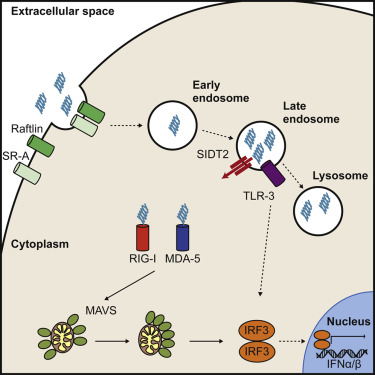Immunity ( IF 25.5 ) Pub Date : 2017-09-12 , DOI: 10.1016/j.immuni.2017.08.007 Tan A. Nguyen , Blake R.C. Smith , Michelle D. Tate , Gabrielle T. Belz , Marilou H. Barrios , Kirstin D. Elgass , Alexandra S. Weisman , Paul J. Baker , Simon P. Preston , Lachlan Whitehead , Alexandra Garnham , Rachel J. Lundie , Gordon K. Smyth , Marc Pellegrini , Meredith O’Keeffe , Ian P. Wicks , Seth L. Masters , Craig P. Hunter , Ken C. Pang

|
Double-stranded RNA (dsRNA) is a common by-product of viral infections and acts as a potent trigger of antiviral immunity. In the nematode C. elegans, sid-1 encodes a dsRNA transporter that is highly conserved throughout animal evolution, but the physiological role of SID-1 and its orthologs remains unclear. Here, we show that the mammalian SID-1 ortholog, SIDT2, is required to transport internalized extracellular dsRNA from endocytic compartments into the cytoplasm for immune activation. Sidt2-deficient mice exposed to extracellular dsRNA, encephalomyocarditis virus (EMCV), and herpes simplex virus 1 (HSV-1) show impaired production of antiviral cytokines and—in the case of EMCV and HSV-1—reduced survival. Thus, SIDT2 has retained the dsRNA transport activity of its C. elegans ortholog, and this transport is important for antiviral immunity.
中文翻译:

SIDT2将细胞外dsRNA转运到细胞质中进行先天免疫识别
双链RNA(dsRNA)是病毒感染的常见副产物,可作为抗病毒免疫力的有效诱因。在线虫秀丽隐杆线虫中,sid-1编码在整个动物进化过程中高度保守的dsRNA转运蛋白,但SID-1及其直系同源物的生理作用仍不清楚。在这里,我们显示哺乳动物SID-1直向同源物SIDT2,是将内化的细胞外dsRNA从内吞区室转运到细胞质中进行免疫激活所必需的。Sidt2暴露于细胞外dsRNA,脑心肌炎病毒(EMCV)和单纯疱疹病毒1(HSV-1)的缺陷小鼠表现出抗病毒细胞因子的产生受损,在EMCV和HSV-1的情况下,存活率降低。因此,SIDT2保留了其秀丽线虫直系同源物的dsRNA转运活性,这种转运对于抗病毒免疫非常重要。











































 京公网安备 11010802027423号
京公网安备 11010802027423号